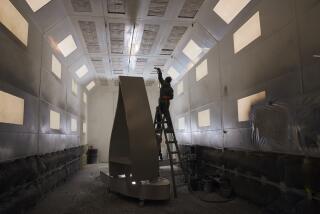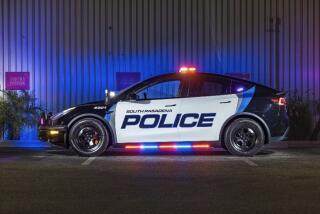Drivers Plug In to the Electrical Alternative
Few people are more pleased with the new wave of electric vehicle endorsements than veterans in the alternative transportation world, where back-yard mechanics have been tinkering with electric conversions for years.
“The interest in electric vehicles and the proliferation of them (are) an avalanche right now,” says writer-consultant Michael Hackleman of Venice, editor of Alternative Transportation News.
Hackleman loves the silence of driving an electric vehicle.
“I hate it when I’m driving a gas-powered car and I stop at a light and hear the damned engine running, its vibration, its noise, its fuel just going away,” he says. “It’s not doing anything useful.”
He built his first electric car in 1975 to complement his environmental lifestyle on a farm in the Sierra near Yosemite.
“The car kept me linked to the need for fuel, and I wanted to disconnect,” Hackleman says. “I was trying to become totally self-reliant.”
He has continued to build prototypes and moved back to the city to concentrate on his crusade when the smog he tried to escape crept into the mountains: “I’ve devoted my time to alternative energies for the do-it-yourselfer, for people who are taking the responsibility and not waiting for someone to put it on the showroom floor.”
The numbers are growing, he says. “What I’m seeing is a younger crowd. Their appetite has been whetted by the solar car races and electric car races.”
There is also the attraction of operating costs. Hackleman’s budget for maintaining an electric vehicle:
* An eight-hour charge is $1.50 daily, although rates vary and some utilities offer EV credits.
* Battery-pack replacement every three years is $1,600, including parts and labor.
* Bearings and brushes for the motor, every three years, $100.
“That’s it,” says Hackleman. “The only servicing the car needs is water in the batteries.”
Kate Priest of Los Angeles, whose E Communications specializes in environmental awareness campaigns, has promoted EV travel for designer Doug Cobb. His Solar Car Corp. unveiled a solar-electric hybrid last April. It is built into a subcompact Ford body and can be recharged from a standard 110-volt circuit or by solar panels on its roof and hood. He has announced plans to mass-produce it.
“Our message is that the technology is viable and practical and available right now,” Priest says. “You don’t have to curtail your lifestyle to drive these cars, and we need to get seriously moving in this direction now.
“There has always been a little subculture of people into electric cars, but in the last year it is gone from the technician’s back yard to the general public. We’re getting tremendous interest from Joe Commuter.”
At Solar Electric in Santa Rosa, which has sold occasional electric vehicles during the last 10 years, president Gary Starr says sales shot up during the last 1 1/2 years. “It’s starting to happen. I think Earth Day helped to awaken latent environmentalists, and so did the Persian Gulf War. Even people who supported it saw the need to get off fossil fuels.”
He says he is back-ordered about 90 days for the electric cars, which are converted Ford Escorts or Ford Tempos. Prices start at $16,000.
The cars have on-board chargers that can be plugged into any electrical outlet, he says: “You can plug into your garage, your office, even throw an extension cord out your hotel window and the car will work.”
More to Read
Inside the business of entertainment
The Wide Shot brings you news, analysis and insights on everything from streaming wars to production — and what it all means for the future.
You may occasionally receive promotional content from the Los Angeles Times.









